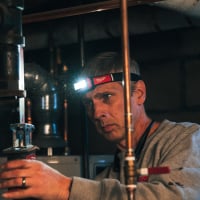Best Of
Re: Replacement for Old School Dual drain slop sink
I had that drain connection on a double sink in my mother's house (mid 1940's).
The sink seemed to be concrete with metal upper protective trim and a washboard built into one of the sloped walls. Very handy with wringer washer and quite durable.
When redoing plumbing I knew to not touch it.
We moved away instead.😊
Re: "Yelp"/ angi list for contractors.
I was on a job about five years ago, another GC situation. 99% of our work is homeowner direct, for the last 20 years. I did more GC stuff in the 90s.
I’m always discussing money flow. My antennas interpret the amount of communication needed. Nobody wants somebody droning on about the same topic, especially money.
We’re at the end of the project and it becomes clear that the money flow isn’t what they said in the beginning. “The person that signs the checks is off this week”. I told the lead guy: “the system will not operate until I have a check on my hand“. About three hours later, the envelope was placed in my hand. It all worked out.
Conversely, we did another GC two years ago. I believe I just stated my general intentions/expectations once in an email. He agreed. That’s all I said. The nice man delivered as promised.
 GW
GW
Re: "Yelp"/ angi list for contractors.
Yeah,
I know your not allowed to "sabotage" the job if you don't get paid, I have heard of that in the past.
GCs always pay late and then their is retainage to deal with.
When we started a job we would tend to "over bill" the progress payments in an order to "get ahead" on late payments.
But you have to be careful with that as well. If you end up having to issue a credit for some reason or have to justify the progress payments it can backfire on you.
Re: "Yelp"/ angi list for contractors.
Got myself into a situation once. Bid a job in Connecticut to install 3 emergency generators in 3 fire stations.
Got quotes on the generators and after I was awarded the job by the town the generator company sprung there terms on me that they wanted all the money when the gens were delivered.
Having just started my business I didn't have much cash laying around and I was in a pickle being locked into my bid.
The gen company had an office in CT and there main office was in NJ. Isent back the proposal with 1/3 of the $$ and stated my terms: 1/3 down, 1/3 on delivery, 1/3 after start up (by the gen people) and acceptance by the town.
They cashed my check.
4 weeks later the Gens were ready and they called me form CT office and wanted all the money
I called the main office in NJ and we got in a scuffle. I told him you cashed the check (you could have returned it) thereby you accepted my terms. Things were ok after that.
Its all about leverage in business. You have to keep some bullets in your gun.
Re: Where can I find Pennsylvania code reqs for residential basement oil tanks?
Most state use NFPA 31.
I have never heard of any requirement for a space from a stone/mortar wall. 2-3" should be fine.
I wouldn't worry about it. Its your installers problem anyhow. If you get into it it will be your problem. You are overthinking it.
Re: "Yelp"/ angi list for contractors.
There was a prevailing wage job I did for the City of San Francisco years ago. It was some radiant heating for a daycare center and the general contractor was always late in paying progress payments. We finished the job and it was signed off by the inspector, but the GC wouldn't pay. I think he came up short. I lost patience and drove to the job, pulled the relays out of the zone valve control and told the director they lost their heat because the GC hadn't paid me my final payment.
I got a call the next morning that they were sending the cops over to arrest me unless I reinstated the heating system and, of course, I did. They must have lit a fire under the GC because I got a check the next week.
Now that I only do service and repair work, I most always get paid by the owner….when the job is done and they are grateful. For the few times I do work for a GC, it's like pulling teeth and I vow never to do it again.
Re: Mystery tool
I've looked at some pics of bed bolt installation on professional woodworking sites. If the nut mortise has a flat surface where the nut sits, the nut is typically installed with the rounded corners facing towards the end of the bolt, as shown in the Whitechapel pic above. If the nut mortise has a curved surface where the nut sits (if the mortise is drilled out with a round Forstner bit), the nut is installed with the rounded corners facing into the curve of the of the round mortise hole. So it can go either way depending on how you cut the mortise.
Re: Mystery tool
I saw one set of bunk beds with exactly the same bolts that @Larry Weingarten posted. Only one I ever saw and it wasn't an old bed.
Re: Literature on Geothermal
looking to stay 40+ deep into the season by alternating loops.
 skyking1
skyking1

